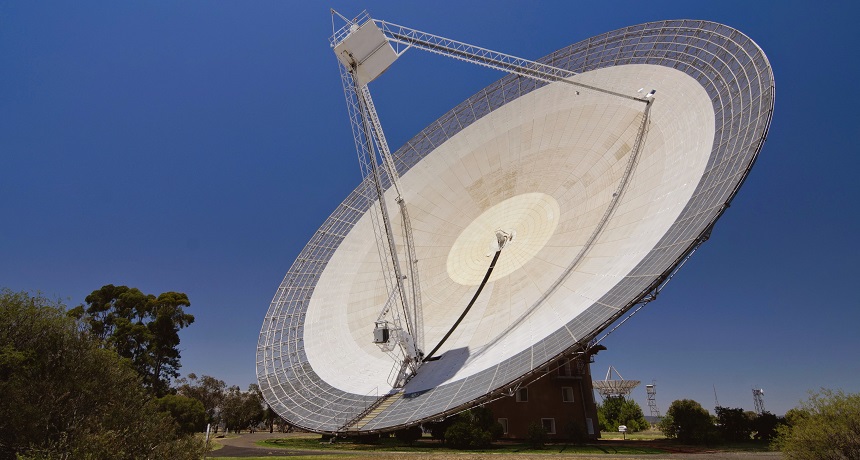Radio telescope picks up signals from intelligent life
Alas, they weren’t sent by space aliens

The “dish” at the Parkes Radio Telescope facility in Australia — listening for signals from distant galaxies (or the staff’s microwave ovens).
Luke Chapman/ Flickr (CC BY-NC-ND 2.0)
On three days in January, the Parkes radio telescope in Australia detected mysterious signals. Their source was an advanced civilization in the Milky Way. Alien-hunters, however, may be disappointed to learn it’s the one civilization we already know plenty about. Ours.
Astronomers traced the signals to microwave ovens. Impatient diners at the telescope facility must have opened the ovens’ doors before the devices had shut down. This allowed pulses of 1.4 gigahertz radio waves to escape. Those bursts resembled ones the astronomers had been hunting — signals known as fast radio bursts, or FRBs.
Such fast bursts had been detected several times. They seemed to be coming from celestial objects in distant galaxies. Those are huge clusters of stars. Among them are pulsars, the spinning ultra-dense corpses of once-massive stars.
Since 2007, astronomers also have picked up what seemed to be FRBs coming from closer to home — perhaps in Earth’s atmosphere. They called these local radio bursts perytons (PAIR-ee-tons). They named them for a mythical winged elk that supposedly cast the shadow of a man. This would have made the animal seem to be something it was not. Just as the perytons seemed to be local bursts masquerading as galactic FRBs, something they were not.
One new clue that the January perytons at Parkes were human-made? Their energy matched the frequency of kitchen microwave ovens. A second big clue was the fact that these bursts occurred only during the work day, such as around lunchtime.
So Parkes researchers spent weeks testing this kitchen hypothesis. Again and again, they heated mugs of water while moving their telescope’s massive radio dish around the sky. No perytons. Finally, they tried something different. They opened the oven door mid-cooking, and suddenly the telescope recorded perytons.
The oven link might be funny except that these microwave pulses from the Parkes kitchen have been muddling the astronomers’ hunt for true FRBs. Although the source of those distant microwave emissions remains a mystery, astronomers suspect they may be linked to neutron stars (which pulsars are made from). FRBs might even stem from eruptions on magnetars, neutron stars with mega-massive magnetic fields.
Emily Petroff of Australia’s Swinburne University of Technology in Hawthorn, Victoria, and her colleagues described online April 9 at arXiv.org how they sleuthed out the truth.
Power Words
(for more about Power Words, click here)
celestial object Any naturally formed objects of substantial size in space. Examples include comets, asteroids, planets, moons, stars and galaxies.
frequency The number of times a specified periodic phenomenon occurs within a specified time interval. (In physics) The number of wavelengths that occurs over a particular interval of time.
galaxy (adj. galactic) A massive group of stars bound together by gravity. Galaxies, which each typically include between 10 million and 100 trillion stars, also include clouds of gas, dust and the remnants of exploded stars.
giga A prefix for units of measurement meaning billion in the international metric system.
hertz The frequency with which something (such as a wavelength) occurs, measured in the number of times the cycle repeats during each second of time. Microwave energy is usually measured in gigahertz, for instance, or a billion cycles per second.
magnetars Neutron stars having a super-intense magnetic field, perhaps one a million billion times as strong as Earth’s.
microwaves An electromagnetic wave with a wavelength shorter than that of normal radio waves but longer than those of infrared radiation (heat) and of visible light.
Milky Way The galaxy in which Earth’s solar system resides.
neutron star The very dense corpse of what had once been a star with a mass four to eight times that of our sun. As the star died in a supernova explosion, its outer layers shot out into space. Its core then collapsed under its intense gravity, causing protons and electrons in its atoms to fuse into neutrons (hence the star’s name). Astronomers believe neutron stars form when large stars undergo a supernova but aren’t big massive enough to form a black hole. A single teaspoonful of a neutron star, on Earth, would weigh a billion tons.
perytons Fast pulses of radio waves that come from some source at or near Earth. Because they resembled pulses emitted by objects in deep space, astronomers named these pulses for a mythical winged elk that cast a human shadow, a critter that seemed to be what it was not.
pulsar The name for a spinning, ultra-dense neutron star. When these stars rotate, they emits short, regular pulses of radio waves or X-rays (and occasionally both at alternate intervals).
radio waves Waves in a part of the electromagnetic spectrum; they are a type that people now use for long-distance communication. Longer than the waves of visible light, radio waves are used to transmit radio and television signals; it is also used in radar.
telescope Usually a light-collecting instrument that makes distant objects appear nearer through the use of lenses or a combination of curved mirrors and lenses. Some, however, collect radio emissions (energy from a different portion of the electromagnetic spectrum) through a network of antennas.







